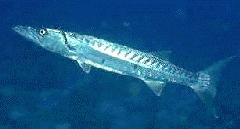First Aid for BARRACUDA BITES

For minor bites, gently pull the edges of the skin open and remove any embedded teeth either by rinsing or using tweezers. Scrub directly inside the wound with clean gauze or a cloth soaked in clean, fresh water. Press on the wound to stop bleeding. If bleeding persists, or the edges of a wound are jagged or gaping, the victim likely needs stitches. Taping a bite shut is often an effective alternative, but may leave a more visible scar than suturing. For more details on wound care, see Staph, Strep and General Wound Care.
Victims who appear pale, sweaty, and nauseated are in danger of fainting. Lower the victim to the ground.
Barracudas can sever arteries or veins. In such cases, victims can die rapidly from blood loss. Often, a rescuer can stop bleeding from severed blood vessels by firmly pressing anything handy (swimsuit, towel, hand) directly on the wound. Such pressure usually causes the vessel to clamp down in spasm, and clots begin to form. In the water, however, this procedure can be nearly impossible, especially while helping a victim to shore, or to a boat. In these cases, when bleeding may be fatal, a tourniquet is appropriate. Tying a surfboard leash or dive mask strap around a massively bleeding limb could save a life.
Help a bleeding victim get out of the water as quickly as possible. At the beach, or in the boat, control bleeding by pressing directly on the wound, then remove any tourniquets. (Leaving tourniquets on can cause permanent damage.) Maintaining pressure on the wound, take the victim to an emergency facility as quickly as possible.
